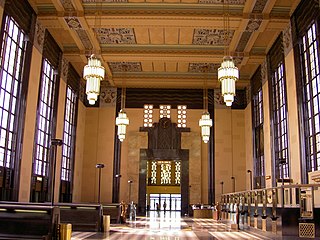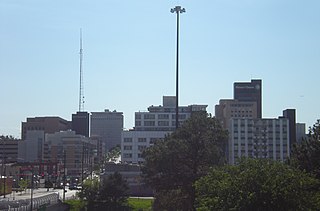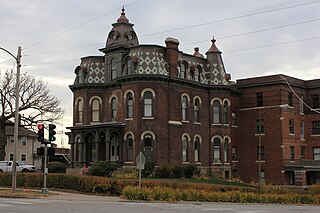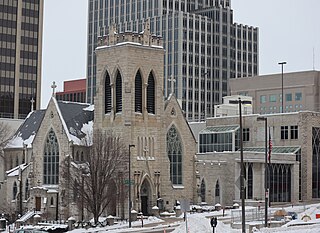
Børsen, is a 17th-century commodity bourse and later stock exchange in the centre of Copenhagen, Denmark. The historic building is situated next to Christiansborg Palace, the seat of the Danish Parliament, on the island of Slotsholmen.

The Maccabees Building is a historic building located at 5057 Woodward Avenue in Midtown Detroit, Michigan. It was listed on the National Register of Historic Places in 1983, and is currently owned by Wayne State University.

The Union Station, at 801 South 10th Street in Omaha, Nebraska, known also as Union Passenger Terminal, is "one of the finest examples of Art Deco architecture in the Midwest". Designated an Omaha Landmark in 1978, it was listed as "Union Passenger Terminal" on the National Register of Historic Places in 1971, and was designated a National Historic Landmark in 2016. The Union Station is also a contributing property to the Omaha Rail and Commerce Historic District. It was the Union Pacific's first Art Deco railroad station, and the completion of the terminal "firmly established Omaha as an important railroad terminus in the Midwest".

Midtown is a geographic area of Omaha, Nebraska that is a culturally, socially and economically important area of the city. It is home to major research centers, national corporations, several historic districts, and a number of historic residences.

Saunders School, located at 415 North 41st Avenue in the Midtown area of Omaha, Nebraska, United States, was declared a landmark by the City of Omaha in 1985, and listed on the National Register of Historic Places in 1986.

Vinton School was built as a fourteen-room elementary school in 1908 at 2120 Deer Park Boulevard in the Deer Park neighborhood of Omaha, Nebraska, United States. Designed by Omaha architect Frederick W. Clarke, Vinton School is the earliest and most elaborate example of a Tudor Revival-style school in Omaha. Designated an Omaha Landmark in June 1990, the building was listed on the National Register of Historic Places in November 1989.

St. Michael's Cathedral is a cathedral of the Orthodox Church in America Diocese of Alaska, at Lincoln and Maksoutoff Streets in Sitka, Alaska. The earliest Orthodox cathedral in the New World, it was built in the nineteenth century, when Alaska was under the control of Russia, though this structure burned down in 1966. After 1872, the cathedral came under the control of the Diocese of Alaska. It had been a National Historic Landmark since 1962, notable as an important legacy of Russian influence in North America and Southeast Alaska in particular.

The Broomfield Rowhouse is located at 2502-2504 Lake Street in the Near North Side neighborhood of Omaha, Nebraska. It was designed by African American architect Clarence W. Wigington, who was later regarded as a master in his field. His design for the house won a 1909 Good Housekeeping competition. The house is listed on the National Register of Historic Places.

The present Douglas County Courthouse is located at 1701 Farnam Street in Omaha, Nebraska, United States. Built in 1912, it was added to the National Register of Historic Places in 1979. Notable events at the courthouse include two lynchings and the city's first sit-in during the Civil Rights Movement. Five years after it was opened, the building was almost destroyed by mob violence in the Omaha Race Riot of 1919.

The Beebe and Runyan Furniture Showroom and Warehouse is located at 105 South 9th Street in Downtown Omaha, Nebraska. The building was listed on the National Register of Historic Places on July 23, 1998, and is a contributing property to the Warehouses in Omaha Multiple Property Submission.

The Joel N. Cornish House is located in South Omaha, Nebraska. The 1886 construction is considered an "excellent example of the French Second Empire style." The house was converted into apartments after the Cornish family moved out in 1911.

The Burlington Headquarters Building, also called Burlington Place, is located at 1004 Farnam Street in Downtown Omaha, Nebraska. This four-story brick building was originally designed by Alfred R. Dufrene and built in 1879 next to Jobbers Canyon. It was redesigned by noted Omaha architect Thomas R. Kimball in 1899, and vacated by the railroad in 1966. The building was listed on the National Register of Historic Places in 1974, designated an Omaha Landmark in 1978, and rehabilitated in 1983. Today it is office space.

The Gottlieb Storz House is located in the Blackstone neighborhood of Midtown Omaha, Nebraska. Built in 1905 by Omaha beer magnate Gottlieb Storz, the mansion was designated an Omaha Landmark on December 21, 1982, and was listed in the National Register of Historic Places on August 7, 1974. It was included in the Gold Coast Historic District when the district was listed in the NRHP on March 14, 1997.

Trinity Cathedral is located in Downtown Omaha, Nebraska. Nebraska's first Episcopal parish, Trinity was established in 1856, and became the state's first Episcopal cathedral in 1872. Designed by noted English architect Henry G. Harrison in 1880, the cathedral was consecrated on November 15, 1883. It was added to the National Register of Historic Places in 1974. Today Trinity Cathedral is considered one of the most beautiful churches in Omaha.

The Elbert P. Tuttle U.S. Court of Appeals Building, also known as U.S. Post Office and Courthouse, is a historic Renaissance Revival style courthouse located in the Fairlie-Poplar district of Downtown Atlanta in Fulton County, Georgia. It is the courthouse for the United States Court of Appeals for the Eleventh Circuit.
Danish Brotherhood in America is a fraternal organization that was founded in 1882 in Omaha, Nebraska. It had about 8,000 members in 2010. A period report said of the Danish Brotherhood, "This is by far the strongest and most influential secular organization about the Danes in America."

St. Anselm's Catholic Church, Rectory and Parish Hall in Anselmo, Nebraska are three separate structures that together form the St. Anselm parish complex. The church, also known as The Cathedral of the Sandhills, was built in 1928–1929, along with the rectory; the parish hall was constructed in 1905 and served as the original church building.

Saint Leonard Catholic Church is a Roman Catholic church in the city of Madison, in the state of Nebraska in the Midwestern United States. Built in 1913, it has been described as "an outstanding example of the Romanesque Revival style of architecture."

The Peterborough Main Post Office is located at 23 Grove Street in Peterborough, New Hampshire. Built in 1936, it is a well-preserved example of Georgian Revival architecture. It is further distinctive because it is virtually unaltered since its construction, and its interior features a WPA mural by Marguerite Zorach. The building was listed on the National Register of Historic Places in 1986.

Family Services Building is a heritage-listed office building at 171 George Street, Brisbane City, City of Brisbane, Queensland, Australia. It was designed by George Gerald Hutton and built from 1914 to 1922. It is also formerly known as Administration Building, Queensland Government Insurance Building, and Queensland Government Savings Bank. It was added to the Queensland Heritage Register on 21 October 1992.
























